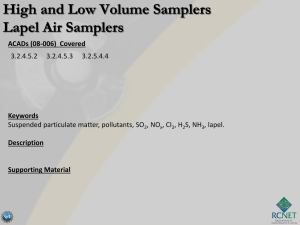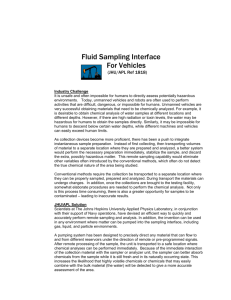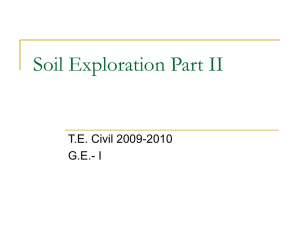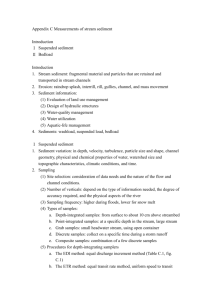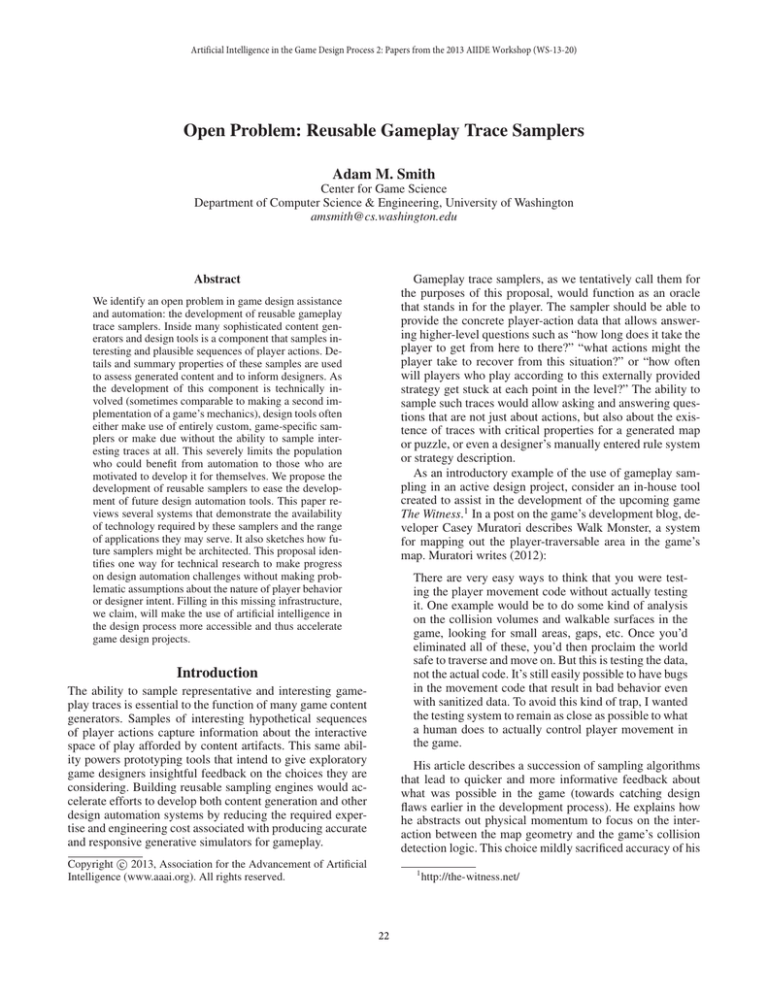
Artificial Intelligence in the Game Design Process 2: Papers from the 2013 AIIDE Workshop (WS-13-20)
Open Problem: Reusable Gameplay Trace Samplers
Adam M. Smith
Center for Game Science
Department of Computer Science & Engineering, University of Washington
amsmith@cs.washington.edu
Abstract
Gameplay trace samplers, as we tentatively call them for
the purposes of this proposal, would function as an oracle
that stands in for the player. The sampler should be able to
provide the concrete player-action data that allows answering higher-level questions such as “how long does it take the
player to get from here to there?” “what actions might the
player take to recover from this situation?” or “how often
will players who play according to this externally provided
strategy get stuck at each point in the level?” The ability to
sample such traces would allow asking and answering questions that are not just about actions, but also about the existence of traces with critical properties for a generated map
or puzzle, or even a designer’s manually entered rule system
or strategy description.
As an introductory example of the use of gameplay sampling in an active design project, consider an in-house tool
created to assist in the development of the upcoming game
The Witness.1 In a post on the game’s development blog, developer Casey Muratori describes Walk Monster, a system
for mapping out the player-traversable area in the game’s
map. Muratori writes (2012):
We identify an open problem in game design assistance
and automation: the development of reusable gameplay
trace samplers. Inside many sophisticated content generators and design tools is a component that samples interesting and plausible sequences of player actions. Details and summary properties of these samples are used
to assess generated content and to inform designers. As
the development of this component is technically involved (sometimes comparable to making a second implementation of a game’s mechanics), design tools often
either make use of entirely custom, game-specific samplers or make due without the ability to sample interesting traces at all. This severely limits the population
who could benefit from automation to those who are
motivated to develop it for themselves. We propose the
development of reusable samplers to ease the development of future design automation tools. This paper reviews several systems that demonstrate the availability
of technology required by these samplers and the range
of applications they may serve. It also sketches how future samplers might be architected. This proposal identifies one way for technical research to make progress
on design automation challenges without making problematic assumptions about the nature of player behavior
or designer intent. Filling in this missing infrastructure,
we claim, will make the use of artificial intelligence in
the design process more accessible and thus accelerate
game design projects.
There are very easy ways to think that you were testing the player movement code without actually testing
it. One example would be to do some kind of analysis
on the collision volumes and walkable surfaces in the
game, looking for small areas, gaps, etc. Once you’d
eliminated all of these, you’d then proclaim the world
safe to traverse and move on. But this is testing the data,
not the actual code. It’s still easily possible to have bugs
in the movement code that result in bad behavior even
with sanitized data. To avoid this kind of trap, I wanted
the testing system to remain as close as possible to what
a human does to actually control player movement in
the game.
Introduction
The ability to sample representative and interesting gameplay traces is essential to the function of many game content
generators. Samples of interesting hypothetical sequences
of player actions capture information about the interactive
space of play afforded by content artifacts. This same ability powers prototyping tools that intend to give exploratory
game designers insightful feedback on the choices they are
considering. Building reusable sampling engines would accelerate efforts to develop both content generation and other
design automation systems by reducing the required expertise and engineering cost associated with producing accurate
and responsive generative simulators for gameplay.
His article describes a succession of sampling algorithms
that lead to quicker and more informative feedback about
what was possible in the game (towards catching design
flaws earlier in the development process). He explains how
he abstracts out physical momentum to focus on the interaction between the map geometry and the game’s collision
detection logic. This choice mildly sacrificed accuracy of his
c 2013, Association for the Advancement of Artificial
Copyright Intelligence (www.aaai.org). All rights reserved.
1
22
http://the-witness.net/
In Game-Specific Projects
Game-specific tools can take advantage of sampling techniques that would not be appropriate to blindly apply to
every game. In the assisted level design tools (Bauer and
Popović 2012; Bauer, Cooper, and Popović 2013) for the
game Treefrog Treasure,2 two internal gameplay trace samplers are used to determine reachability between different
points in a level design under construction. An initial sampler, based on rapidly-exploring random trees or RRTs3
(LaValle and Kuffner 2001), determines overall reachability
between different platforms in the game’s map. After each
local edit to the map, a custom dense sampling process reestimates the proportion of moves that could be made between each pair of platforms of interest. While the first version of this system made calls to the actual game to perform
simulated actions (resulting in an ability to sample on the order of five moves per second), the subsequent version used
genre-specific knowledge about the shape of jump paths to
replace a frame-by-frame physics simulation with a jumpat-a-time simulator based on intersecting analytic curve segments (allowing hundreds of simulated moves per second).
In a related performance-oriented prototype,4 careful attention to the sampling process allowed sampling hundreds of
thousands of moves per second for the same movement mechanics. In general, there are many ways to trade small decreases in simulation accuracy for massive increases in sampling rate, but the scope of these approximations is limited
to games with similarly structured mechanics.
In another project from the same group, Butler et al.
(2013) provide interactive feedback on manual edits as part
of a mixed-initiative design tool for the puzzle game Refraction.5 Their level analyzer works by sampling solution traces
that avoid practicing critical gameplay concepts. The presence or absence of these solutions feeds into a visualization
of which concepts a puzzle requires across all of its solutions. Although this sampler depends on game-specific code
(approximately 150 lines of code that define the game’s mechanics and solution conditions), the engine that searches for
satisfying solutions is quite general (Smith et al. 2012). The
same idea is used in their level generator which makes use
of exhaustive machine playtesting internally (Smith, Butler,
and Popović 2013).
As Refraction is a turn-based puzzle game with deterministic mechanics played on a coarse grid, extracting out just
those mechanics relevant for efficient and informative sampling is not as hard as it is for other games. In Togelius’ personalized racetrack generator (2007), just a single gameplay
trace (for a player-specific driver model) is sampled for each
track considered by the generator because of the frame-byframe physics involved in the game. If a probabilistic driver
model were to be used (allowing the system to know that
a driver could only make a critical turn 20% of the time),
many samples would need to be taken, either putting pres-
Figure 1: A custom sampling algorithm for traversable spatial paths in The Witness reveals a design bug. The red hole
in the center outlines an invisible collision body mistakenly
left on the map. (This screenshot was reproduced from Muratori’s blog post with permission from the developers.)
sampler in favor of reduced time to gather the sampling coverage he sought, a balancing choice any sampling system architect must make. In use, the system identified that a particular patch of rocks was traversable by the player, despite the
intent for them to be an impassible barrier. Movement samples found by the tool (and later reproduced in live gameplay) further revealed this this patch was only traversable
in one direction, potentially allowing the player to become
stuck. In another instance (visualized in Figure 1), the lack
of traces crossing one area of the map highlighted the fact
that a collision body had been left there after its graphical
counterpart had been removed.
Even with the need for original algorithm design, Muratori is convinced that his effort in making and applying the
sampler were worth the effort. In his closing thoughts, he
ponders what other design queries might also be served by
moderate extensions to his experiment. It is unrealistic to
ask every other developer to take the blind leap into sampler
design in the way that this developer did, but, with reusable
infrastructure, others might be persuaded to try and see what
benefits can be had for their own projects.
In the body of this proposal, we review several existing
systems that internally perform functions similar to our proposed samplers and demonstrate potentially reusable technology for developing them. We also sketch possible architectures for samplers in terms of their inputs, internal processes, outputs, and possible modes of packaging for use in
specific game design projects. Finally, we examine the potential impact of the proposal on technical research in and
outside of game content generation.
Samplers in the Wild
The seeds of potential reusable gameplay trace samplers are
scattered in two directions: in game-specific samplers that
could be generalized to talk about other games in their target genres, and in already-general sampling tools that can
be made more specific for improved accessibility in game
development projects.
2
http://www.kongregate.com/games/gamescience/treefrogtreasure
3
Muratori also explored using RRTs in Walk Monster.
4
http://adamsmith.as/typ0/k/frogsplat/
5
http://www.kongregate.com/games/gamescience/refraction
23
Jaffe’s later work examined the possibility of Monte Carlo
tree search (MCTS) for this purpose (2013). If efficient
and reusable samplers are available for a variety of game
types, many interesting design questions can be automatically probed. To do this, the designer poses and interprets
the results of queries for gameplay traces under restriction
on play. In this application, the sampler does not judge what
is good or bad design, but it does provide an “early warning
system” for notable imbalances.
Automatic navigation mesh construction (Tozour 2002) is
an example of a reusable designer assisting technology that
has already been widely adopted within the game industry.
These meshes, however, are most often computed directly
from the geometry of a level design. As Muratori reminds
us, this data-only analysis misses interactions between the
game’s varied mechanics and the fixed geometry. Reusable
gameplay trace samplers might someday allow the automatic construction of more general ‘action meshes’ which
captured not just possible navigation actions but engagement
with other mechanics such as triggering of switches, unlocking doors, collecting/crafting/using items, or dialog exchanges. The boundaries between spatial pathfinding, action
planning, and abstract puzzle solving would become blurred
in such systems.
sure on the sampler to perform much faster or the generator to glean the same information from traces sampled with
a coarser physics timestep. In the generator for Cloudberry
Kingdom, a procedural platformer game hyped for its “insane” levels (Fisher 2012), generated levels are guaranteed
to be feasible (possible to complete) by constructing a reference path. After each new design element is added to the
level, such as platform or fireball, the reference trace must be
re-simulated to check the path’s feasibility. Game-specific
techniques could be invented to speed up sampling for either of these games, but unless they are shared and made
reusable, it is only the daring sampler developers who will
rediscover them in new projects.
In General Game Design Tools
General-purpose gameplay trace sampling is far from impossible. Game prototyping systems such as L UDOCORE
(Smith, Nelson, and Mateas 2010) and the Machinations
framework (Dormans 2011) offer trace sampling for any
game representable in their abstract and diagrammatic modeling languages. In L UDOCORE, a model of the game’s mechanics, world configuration, player behavior, and context
of designer interest are encoded in a common logical modeling language. In response to these heavyweight queries,
the system produces one or more example gameplay traces
demonstrating the required (and potentially extremely rare)
behavior. No statistical properties, however, are promised
over the output. The Machinations framework, by contrast,
takes a lightweight approach where samples are constructed
by independent forward-simulation runs. To sample specific
types of traces (e.g. to explore a certain strategy), imperative
scripts can be written to conditionally trigger events in each
sampled run.
The presence and probabilistic distribution of gameplay traces with interesting properties can directly translate
into design insight regarding a design under test. In L UDI
(Browne and Maire 2010), “a system for playing, measuring, and synthesizing games,” an estimate of the quality of
a given strategic board game is made by taking many samples of its typical gameplay (as generated by generic strategic search agents). Whether the distribution of samples has
properties such as bias for or against the first player, too often ending in a draw, or never indicating the possibility of
dramatic reversals partially reflects the nature of the game.
However, properties of these samples also reflect the nature
of assumptions the system made about how typical players
play.
To gain deeper insight into which facets of a game design
are responsible for its balance, Jaffe et al. (2012) argue for
examining the outcome of competitive play under designerprescribed restrictions on the behavior of one player or another. For example, to judge the impact of a particular action, they examine the relative win rate of a player who can
only use that action up to a constant number of times against
an unrestricted opponent. Although the system they describe
is based on exhaustive analysis of the complete game tree,
systems that attempt to provide the same insight for more
expansive game trees (such as those derived from complex
videogames) will come to depend on sampling techniques.
Architectural Choices
In this section, we sketch the architecture of potential samplers. Depending on the choice of inputs, internal processes,
and outputs, a trace sampler might be better named by other
terms such as trace simulator, trace planner, or trace constraint solver. In each of the architectural facets below, a satisfying system need not implement every possibility, instead
only a combination that works well together.
Inputs
A sampler’s input defines the game in question and poses a
specific query to focus the samplers attention. Thus, the sampler’s input should contain details such as the level design in
question and the initial state of the player and non-player
characters. Similarly, the input should describe the relevant
victory or loss conditions associated with the scenario (such
as reaching a key location within allotted time or touching
objects of a certain type). The sampler will not always be
asked to find traces resulting in the victory or loss conditions, but telling the sampler when a trace would result in
termination of a gameplay session is part of how the game is
defined.
Beyond defining a session’s initial and final conditions,
the sampler should take a description of the specific mechanics of the game (either as a symbolic description or direct
callback mechanism). Within a given genre, many low-level
mechanics may be assumed, and a smaller collection of rules
and parameters can define the specifics of a game in terms of
the same abstractions afforded by the game engine on top of
which it is built. The granularity of simulation used by the
sampler need not exactly match that of the game in question.
Abstract simulations, for example, could be used to answer
tentative design questions for early-stage game designs before the fine-grained details have been fully worked out.
24
the same kind of algorithms that power the various agents
that participate in general game playing (GGP) competitions
(Genesereth, Love, and Pell 2005). The trace-sampling problem, however, will not always be aligned with the strengths
of common tree search algorithms. For example, the relevance of a trace (deciding if the sampler should emit the
trace) may not be representable as a simple reward function
over states. Instead, it may depend on properties of the sequence of actions taken. As a result, different internal sampler processes may be better suited to answering different
types of queries.
The above inputs would be sufficient for a sampler to
draw from a default distribution over all play traces (perhaps taking every available action with uniform probability). In order to sample more interesting traces, the sampler
should also take a description of the expected player behavior. This could be provided as either an explicit distribution
over actions as a function of game state (perhaps derived
from previously collected observations of human players)
or as a callback to a system outside of the sampler to get
a distribution over moves. This information would ensure
that traces emerging from the sampler are realistic, but they
might still be irrelevant to the design concern in question.
Thus, the sampler should also take an optional description
of any other property that should be required of the sampled
traces. This might be the constraint that the traces all end in
a certain state, that actions of a certain type are never used
(despite the provided player model suggesting their preference), or that conditions outside of the player’s control are
structured in a certain way (perhaps that enemies should be
assumed to always fail their first attack). Whether this information is provided as explicit constraints or as a function
over game state and player actions that should be optimized
is a choice left for the sampler’s architect.
Outputs
Depending on the level of detail used by the gameplay simulation and the scope of the query, different samplers may
intentionally provide outputs at different granularities. For
example, one sampler may only report high-level moves in
an approximation of the game, perhaps under the extra constraint that each sample is unique and the collection of samples exhausts the possibilities of a given size. This might be
used to enumerate build orders in an RTS game that, under
abstraction, result in a sufficiently strong economy within a
certain time limit. Alternatively, a sampler that operates over
a very accurate model of the game’s mechanics might report
pixel and/or frame-accurate traces that can be replayed exactly within the target game.
It might be tempting to directly output aggregate statistics
or other metrics over possible traces in an effort to directly
answer a design-level question. We suggest that architects of
samplers focus on emitting informative and concrete gameplay traces wherever possible. This will allow a larger system employing the sampler to draw its own inferences (even
if it means simply tracking the counts of traces with certain
properties or plotting their extent on a map) and avoid feature creep in the design of the sampler itself that might limit
its reusability. The sampler’s job is to draw samples, not to
interpret those samples on behalf of others.
Processes
Three broad directions for the internal processes used by the
sampler are particularly clear to us. In the first direction,
the sampler would be organized as a statistically-sound sampling process. Such a system would draw samples with the
guarantee that the sample distribution converges to a welldefined theoretical distribution (associated with the query
to the sampler). Probabilistic programming languages like
Church (Goodman et al. 2008) offer these semantics for a
Scheme-like general-purpose programming language. These
general-purpose languages fall short of desirable, for our application, by providing no special support for creating and
refining models of gameplay for any particular game genre.
Nevertheless, such a language could be used inside of a sampler with the help of a library that forms, in effect, a probabilistic game engine for the genre in question.
The second direction, also inspired by the availability
of tools for analyzing general-purpose programs, is to use
tools emerging from the software model checking community. PRISM (Kwiatkowska, Norman, and Parker 2011), for
example, is a probabilistic model checker that accepts a
model of a program and a formal property to check, such
as whether a certain class of states is reachable from the
initial conditions. PRISM and similar systems can output
either detailed instances (interpretable as execution traces)
that falsify a critical property or report summary statistics
on those traces satisfying the property. Meanwhile, CBMC
(Clarke, Kroening, and Lerda 2004) is a model checker that
operates on programs defined by standard ANSI-C and C++
sources (potentially allowing exact symbolic inference about
the functioning of the same code used by the game in question without directly executing it in a callback, similar to
L UDOCORE).
The third direction is to employ general game tree search
methods such as MCTS (Tavener et al. 2012). These are
Packaging
Reusable samplers become useful only when integrated into
a project-specific context. Perhaps the simplest way to package a sampler would be as a library that provides a modeling and query API (with an eye towards direct integration into larger tools and designer-facing visual interfaces).
This approach allows for easy integration of hooks and callbacks. Another approach is to package the system as a
network-accessible service with a well-defined query language (akin to a database engine). This language-agnostic
approach would be a convenient way to expose cluster and
cloud computing resources for use in design automation purposes while shielding consumers of the sampler from the associated system complexity. Yet another alternative would
be providing a domain specific programming language and
interpreter (where programs define the game model and
query, and, when run, produce a result set of samples). This
self-contained approach might be best useful for very exploratory design processes where performance and integration are not yet serious concerns while keeping the rapidly
changing game model in one place is preferred.
25
Discussion
Reusability demands some degree of generality in how
games are represented for or exposed to the sampler (though
generality across genres is not an immediate concern). Even
in the context of a single game design project, the ability to
reuse a sampler across several design iterations would be desirable. The developers of a sampler are responsible for designing representations for game mechanics, player behavior, and other conditions on traces that balances the interests
of generality with immediate usefulness on design projects
in a specific genre. Game engine developers are in a good
position to make some of these choices on behalf of the developers who use their engine (in the same way that a game
engine might support a single type of navigation mesh for
all client games).
Advanced state-space and symbolic model checking tools
internally make use of state-of-the-art combinatorial search
algorithms (Edelkamp et al. 2008). The technical expertise
required to reliably implement such advanced techniques is
unlikely to overlap with the expertise needed to develop rich,
genre-specific design tools. Although samplers can provide
centralized implementations of powerful but otherwise inaccessible algorithms, some effort will always be needed to
translate the abstract outputs of these techniques into gamerelevant terms.
As many instances of the gameplay trace sampling are
structurally similar to the problem of sampling photon paths
in graphics applications (ray tracing), there are significant
opportunities for parallelization, approximation, and sophisticated sampling methods. To pick just one example, beam
tracing is alternative to ray tracing that, instead of tracking
individual rays of infinitesimal width, models thick beams
of light which account for bundles of related paths, accounting for whole polygonal surfaces at a time (Heckbert and
Hanrahan 1984). In any one application, these advanced implementation techniques might be ignored in the interest of
engineering costs, but, in a reusable system, applying these
methods become much more attractive.
Having sketched the array of existing samplers and explored
potential architectural choices for reusable samplers in the
future, we now look at the effect of sampler development on
technical game research programs.
Problematic Assumptions
Returning to the context of design automation, the development of reusable samplers would provide a productive outlet for technical research in a way that avoids making problematic assumptions. It is common for game content generators (such as level generators) to make explicit and architecturally fixed assumptions about what makes for good
game design or what the imagined designer (the user) always
wants from the generated content. Inside these systems, the
component responsible for generating representative gameplay traces for evaluation makes similarly problematic assumptions about how players behave: that just one trace or
a very sparse collection of traces is representative of the target audience (such as in Cloudberry Kingdom), or that the
distribution over traces emerging from the system’s fixed
search process is always representative (such as in Ludi).
Smith et al. examine the design implications of undersampling in more detail (2013).
Where possible, the criteria for what makes a gameplay
trace interesting should be taken as an input (if they can be
declaratively described) or made available to the sampler via
hooks or callbacks to project-specific systems outside of the
sampler instead of being fixed internally. The intent is to
allow a designer to ask new questions on a whim, without
re-engineering the sampler, or allowing an enclosing system, such as a game-specific content generator, to treat the
sampler as a trusted and informative oracle for the tracesampling problem.
In content generation systems, often a mix of easy-toformalize gameplay properties (e.g. reachability in interactive play) are combined with hazily defined properties (e.g.
visual aesthetics). Instead of treating both types of concerns
uniformly in a generator’s search process, reusable gameplay trace samplers could provide clear and objective evidence to judge the formalizable properties of the content
artifact. This would decouple the design of the search process that is responsible for exploring an artifact’s gameplay
from the search process responsible for finding good artifacts (where guarantees about the semantics of outputs are
much more informative for the inner search process than the
outer process). That a larger design automation system deals
with informal properties need not imply that the sampling
subsystem works on an equally informal basis.
Extended Reach
If samplers are going to give designers visibility into the
broad space of play for the games they support, they need to
explore this space significantly faster than the designers can
do themselves in traditional playtesting. We conjecture that
the quality of insight a sampler can generate is proportional
to the logarithm of the number of traces considered by the
sampler times a factor related to the level of abstraction used
by the sampler. As a result, systems that intend to deliver
deep insight for designers (or precise metrics for larger automated systems) will demand that samplers have a wide reach
across the space of play arising from a query scenario. This
implies, compared to a reference setting of manual playtesting, we should demand a significant increase over real-time
simulation. Whether this extended reach should be provided
by clever abstraction or aggressive parallelization, however,
is a subjective design choice.
Technical Expertise & Engineering Costs
In the ideal case, technical work put into implementing
reusable samplers displaces equivalent work that would have
been required to produce a project-specific sampler in larger
projects requiring one. Here, we look at look at the potential
costs associated with developing samplers as a way to both
estimate what effort can be saved and what effort must be
expended to produce these samplers.
New Applications
Absent the availability of samplers, many applications that
depend on them, particularly design tools that might rely on
26
them for interactive feedback, cannot be explored. In a platformer level design setting, geometric platforms could snap,
not just to a uniform grid, but to the point of first player
reachability from other platforms. For post-deployment
analysis, it should be possible to sample low-level gameplay
details that are consistent with high-level log data, allowing statistical inference over unrecorded properties of human player traces. Being able to sample alternative futures
from snapshots of game state observed during high-interest
play (e.g. eSports) would allow running detailed what-if scenarios from player models fit to expert play styles. Until
such samplers are readily available, we can only speculate
on other what new applications might be opened up.
Dormans, J. 2011. Simulating mechanics to study emergence in
games. In Workshops at the Seventh Artificial Intelligence and Interactive Digital Entertainment Conf.
Edelkamp, S.; Schuppan, V.; Bosnacki, D.; Wijs, A.; Fehnker,
A.; and Aljazzar, H. 2008. Survey on directed model checking. In AAAI Wksp. on Model Checking and Artificial Intelligence
(MoChArt), 65–89.
Fisher, J. 2012. How to make insane, procedural platformer levels. Gamasutra. http://www.gamasutra.com/view/feature/170049/
How to Make Insane Procedural Platformer Levels .php.
Genesereth, M.; Love, N.; and Pell, B. 2005. General game playing: Overview of the AAAI competition. AI Magazine 26(2):62.
Goodman, N. D.; Mansinghka, V. K.; Roy, D. M.; Bonawitz, K.;
and Tenenbaum, J. B. 2008. Church: A language for generative
models. In Proc. Conf. on Uncertainty in Artificial Intelligence
(UAI2008), 220–229.
Heckbert, P. S., and Hanrahan, P. 1984. Beam tracing polygonal
objects. In ACM SIGGRAPH Computer Graphics, volume 18, 119–
127. ACM.
Jaffe, A.; Miller, A.; Andersen, E.; Liu, Y.; Karlin, A.; ; and
Popović, Z. 2012. Evaluating competitive game balance with restricted play. In Proc. Artificial Intelligence and Interactive Digital
Entertainment Conf., 26–31.
Jaffe, A. 2013. Understanding Game Balance with Quantitative
Methods. Ph.D. Dissertation, University of Washington.
Kwiatkowska, M.; Norman, G.; and Parker, D. 2011. PRISM 4.0:
Verification of probabilistic real-time systems. In Gopalakrishnan,
G., and Qadeer, S., eds., Proc. Conf. on Computer Aided Verification, volume 6806 of LNCS, 585–591. Springer.
LaValle, S. M., and Kuffner, J. J. 2001. Randomized kinodynamic planning. The International Journal of Robotics Research
20(5):378–400.
Muratori, C.
2012.
Mapping the islands walkable surfaces. http://the-witness.net/news/2012/12/mapping-the-islandswalkable-surfaces/.
Smith, A. M.; Andersen, E.; Mateas, M.; and Popović, Z. 2012.
A case study of expressively constrainable level design automation
tools for a puzzle game. In Proc. Foundations of Digital Games
Conf., 156–163. ACM.
Smith, A. M.; Butler, E.; and Popović, Z. 2013. Quantifying over
play: Constraining undesirable solutions in puzzle design. In Proc.
Foundations of Digital Games Conf.
Smith, A. M.; Nelson, M. J.; and Mateas, M. 2010. Ludocore: A
logical game engine for modeling videogames. In Comp. Intel. and
Games (CIG), IEEE Conf., 91–98.
Tavener, S.; Perez, D.; Samothrakis, S.; and Colton, S. 2012. A
survey of monte carlo tree search methods. Computational Intelligence and AI in Games, IEEE Trans. on.
Togelius, J.; De Nardi, R.; and Lucas, S. M. 2007. Towards automatic personalised content creation for racing games. In Computational Intelligence and Games, IEEE Symp., 252–259. IEEE.
Tozour, P. 2002. Building a near-optimal navigation mesh. AI
game programming wisdom 1:171–185.
Closing Challenge
The technology required to develop reusable samplers is
available, but it needs to be repackaged in a more useful
way. In particular, generic sampling procedures need to be
demonstrated in a way that makes their usefulness in game
design processes clear. Game-specific shortcuts and assumptions should either be generalized or factored out of the design of the samplers to improve reusability. Meanwhile, new
applications that were not possible in a world without access
to samplers should be explored.
The challenge to developers of these samplers is to make
them reusable across game designs so that design exploration (assumed to be contained within a single genre at a
time) is cheap to setup and apply. In order to be useful, the
interface (likely at the level of APIs) needs to expose enough
control that interesting and unforeseen game and designerspecific questions can be asked and answered by sampling
specific kinds of traces. Samplers should just sample, accurately, efficiently, and in a programmable direction, leaving
summarization and interpretation to project-specific components.
We hope this open problem definition spurs development
of technology that changes the conversation around the use
of artificial intelligence and other forms of automation in the
game design process from “we’ve never tried something like
that before” to “we’re looking for a sampler that works for
our game’s genre.”
References
Bauer, A., and Popović, Z. 2012. RRT-based game level analysis,
visualization, and visual refinement. In Proc. Artificial Intelligence
and Interactive Digital Entertainment Conf.
Bauer, A.; Cooper, S.; and Popović, Z. 2013. Automatic redesign of
local playspace properties. In Proc. Foundations of Digital Games
Conf.
Browne, C., and Maire, F. 2010. Evolutionary game design. Computational Intelligence and AI in Games, IEEE Trans. on 2(1):1–
16.
Butler, E.; Smith, A. M.; Liu, Y.; and Popović, Z. 2013. A mixedinitiative tool for designing level progressions in games. In Proc.
User Interface Software and Technology, ACM Symp. on.
Clarke, E.; Kroening, D.; and Lerda, F. 2004. A tool for checking
ANSI-C programs. In Jensen, K., and Podelski, A., eds., Tools and
Algorithms for the Construction and Analysis of Systems (TACAS),
volume 2988 of LNCS. Springer Berlin / Heidelberg. 168–176.
27

